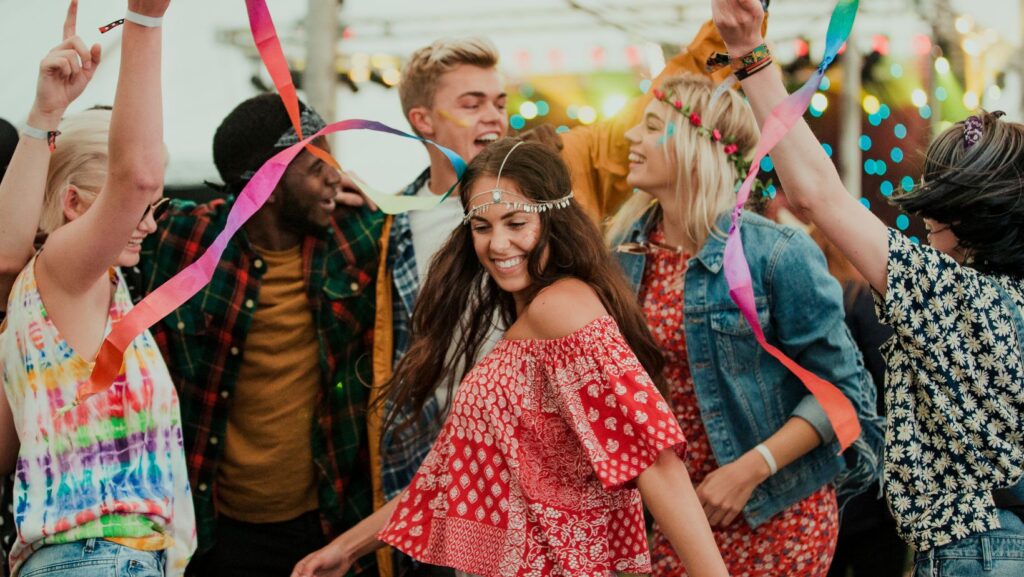Music has long been a powerful force in shaping fashion and culture. From the rebellious rock ‘n’ roll era of the 1950s to the hip-hop revolution of the 1980s, music genres have consistently influenced the way people dress, think, and express themselves. This dynamic interplay between music, fashion, and culture continues to evolve, reflecting societal changes and pushing the boundaries of creativity.
The Historical Connection Between Music and Fashion
The 1950s and Rock ‘n’ Roll
The 1950s marked the rise of rock ‘n’ roll, a genre that brought a youthful rebellion to the forefront of popular culture. Icons like Elvis Presley and Chuck Berry not only revolutionized music but also set fashion trends. Leather jackets, slicked-back hair, and blue jeans became symbols of a generation seeking freedom and individuality.
The 1960s and Psychedelia
The 1960s were a time of social upheaval and experimentation. Psychedelic rock bands like The Beatles and The Rolling Stones not only influenced music but also fashion. Bright colors, tie-dye shirts, and bell-bottom jeans became synonymous with the counterculture movement. This era showcased how music could inspire radical changes in fashion, challenging traditional norms.
The 1970s and Disco
The 1970s brought the disco craze with its flashy, glamorous style. Bands like ABBA and the Bee Gees popularized platform shoes, sequined dresses, and flared pants. Disco fashion was all about standing out and making a statement, reflecting the music’s upbeat and extravagant nature.
Modern-Day Influences
Hip-Hop and Streetwear
The rise of hip-hop in the late 20th century had a profound impact on fashion. Artists like Run-D.M.C., Tupac Shakur, and Notorious B.I.G. introduced streetwear to mainstream culture. Baggy jeans, oversized shirts, and flashy accessories became staples of the hip-hop fashion scene.

Today, brands like Supreme and Off-White continue to draw inspiration from hip-hop culture, blending luxury with street style.
Pop Music and High Fashion
Pop stars such as Madonna, Lady Gaga, and Rihanna have consistently pushed fashion boundaries. Their bold choices and collaborations with high-fashion designers have blurred the lines between music and the fashion industry. These artists use fashion as a tool for self-expression, often setting trends that are followed by millions worldwide.
Electronic Dance Music (EDM) and Festival Fashion
The EDM scene has spawned a unique fashion culture centered around festivals like Coachella and Tomorrowland. Bright, neon colors, eclectic patterns, and minimalistic outfits define festival fashion. This style reflects the vibrant, energetic atmosphere of EDM music and the sense of community among festival-goers.
Cultural Impacts
Shaping Social Movements
Music and fashion have often been at the forefront of social movements. For instance, the punk rock movement of the 1970s was a reaction against the perceived excesses of mainstream culture. Punk fashion, characterized by ripped clothing, leather, and studs, became a visual representation of anti-establishment attitudes.
Globalization and Cultural Exchange
In today’s interconnected world, music and fashion trends spread rapidly across borders. K-pop, for example, has not only taken over the global music charts but also influenced fashion trends worldwide. Fans emulate the styles of their favorite K-pop idols, showcasing the powerful cultural exchange facilitated by music.
Technology and Innovation
The digital age has further intertwined music and fashion. Social media platforms allow artists and influencers to share their styles instantly, reaching a global audience.

Virtual fashion shows and digital clothing collections are becoming more common, demonstrating the innovative ways in which music and fashion continue to evolve.
Diversification of Influences
With the advent of digital platforms, the diversification of influences in music and fashion is more pronounced than ever. Various subcultures can now emerge and coexist, each with its unique blend of musical and sartorial styles. For example, platforms like SpinBet casino illustrate how modern digital spaces can merge different entertainment forms, showcasing how fashion and music trends influence even online environments.
Conclusion
The relationship between music, fashion, and culture is symbiotic and ever-evolving. Each genre of music brings with it new trends and cultural shifts, influencing how people express themselves through clothing and lifestyle. As technology continues to advance and globalize, this interplay will undoubtedly grow even more complex and impactful. Music and fashion will remain powerful tools for cultural expression, continually shaping and reflecting the world around us.
4o

